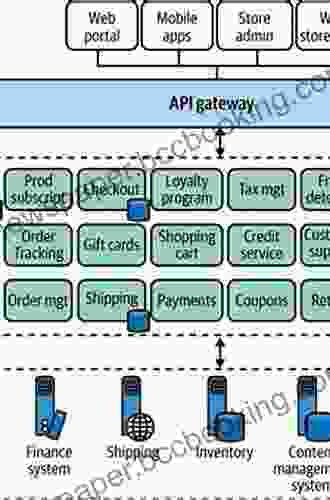Design Patterns for Cloud-Native Applications: Unlocking Scalability, Flexibility, and Resilience

The advent of cloud computing has revolutionized application development, enabling organizations to build and deploy scalable, resilient, and flexible solutions on a global scale. However, the intricacies of cloud-native architectures demand a paradigm shift in design practices to fully exploit their transformative potential. This comprehensive article introduces the essential design patterns for cloud-native applications, empowering developers and architects to craft robust and effective cloud solutions.
Cloud-Native Design Principles
Before delving into specific design patterns, it's crucial to understand the fundamental principles that underpin cloud-native application development:
4.3 out of 5
| Language | : | English |
| File size | : | 26608 KB |
| Text-to-Speech | : | Enabled |
| Screen Reader | : | Supported |
| Enhanced typesetting | : | Enabled |
| Print length | : | 535 pages |
Microservices Architecture: Breaking down applications into smaller, independent services facilitates scalability, loose coupling, and accelerated development.Containerization: Encapsulating applications within containers ensures portability, version control, and simplified deployment.Elastic Scaling: Cloud-native applications automatically adjust their resource consumption based on demand fluctuations, ensuring resource optimization.Fault Tolerance: Built-in mechanisms handle errors and failures gracefully, ensuring high availability and resilience.Continuous Deployment: Automated deployment pipelines with reduced lead times streamline the release and update process.
Core Design Patterns
A comprehensive suite of design patterns provides a foundation for tackling specific challenges in cloud-native environments:
1. Microservice Decomposition
This pattern focuses on decomposing monolithic applications into independent microservices. Each microservice is responsible for a well-defined set of functionalities, promoting scalability, independent deployment, and easier code maintenance.
2. Asynchronous Messaging
Unlike traditional synchronous communication, asynchronous messaging enables services to send and receive messages without waiting for a response. This pattern enhances scalability, as services can handle more requests concurrently.
3. API Gateway
An API gateway acts as a single entry point for all incoming requests to an application. It can enforce security policies, perform authentication and authorization, and route requests to appropriate back-end services.
4. Service Discovery
In dynamic cloud environments, it's essential to have a reliable method for services to locate and communicate with each other. Service discovery mechanisms provide a centralized registry to store and retrieve the addresses of available services.
5. Circuit Breaker
The circuit breaker pattern introduces a resilience mechanism that prevents cascading failures. If a service becomes unavailable or unreliable, the circuit breaker "trips," preventing further requests from being sent to it until the issue is resolved.
6. Load Balancing
Load balancing distributes incoming requests across multiple instances of a service, ensuring optimal resource utilization and reducing response latency. Cloud providers typically offer managed load balancers that automate this process.
7. Autoscaling
Autoscaling dynamically adjusts the number of server instances based on demand. When traffic increases, the system automatically scales up, and when traffic decreases, it scales down, optimizing costs and ensuring performance.
Best Practices
While the aforementioned design patterns are essential, adhering to best practices further strengthens the foundation of cloud-native applications:
Use Cloud Services Wisely: Leverage cloud-native services such as managed databases, message queues, and serverless functions to reduce operational overhead and improve efficiency.Embrace DevOps: Foster collaboration between developers and operations teams to streamline application development, deployment, and maintenance.Implement Monitoring and Logging: Establish comprehensive monitoring and logging frameworks to gain insights into application performance, identify errors, and respond swiftly to issues.Enforce Security Best Practices: Implement robust security measures to protect applications from threats and vulnerabilities, including encryption, access control, and vulnerability scanning.
Design patterns are indispensable tools that empower developers to architect cloud-native applications that are scalable, flexible, resilient, and secure. By embracing cloud-native design principles and leveraging these patterns, organizations can unlock the full potential of cloud computing and drive digital transformation.
Remember, the cloud-native landscape is continuously evolving. Staying abreast of emerging trends and technologies is crucial to building future-proof applications that can withstand the test of time. With this in mind, we encourage you to explore additional resources and engage with the cloud-native community to further enhance your knowledge and skills.
4.3 out of 5
| Language | : | English |
| File size | : | 26608 KB |
| Text-to-Speech | : | Enabled |
| Screen Reader | : | Supported |
| Enhanced typesetting | : | Enabled |
| Print length | : | 535 pages |
Do you want to contribute by writing guest posts on this blog?
Please contact us and send us a resume of previous articles that you have written.
 Book
Book Novel
Novel Page
Page Chapter
Chapter Text
Text Story
Story Genre
Genre Reader
Reader Library
Library Paperback
Paperback E-book
E-book Magazine
Magazine Newspaper
Newspaper Paragraph
Paragraph Sentence
Sentence Bookmark
Bookmark Shelf
Shelf Glossary
Glossary Bibliography
Bibliography Foreword
Foreword Preface
Preface Synopsis
Synopsis Annotation
Annotation Footnote
Footnote Manuscript
Manuscript Scroll
Scroll Codex
Codex Tome
Tome Bestseller
Bestseller Classics
Classics Library card
Library card Narrative
Narrative Biography
Biography Autobiography
Autobiography Memoir
Memoir Reference
Reference Encyclopedia
Encyclopedia Madeline Hunter
Madeline Hunter Montana Hodges
Montana Hodges Kt Johnston
Kt Johnston Steven Weitzman
Steven Weitzman Robert Mccloskey
Robert Mccloskey Virginia Matheson Hooker
Virginia Matheson Hooker Julia Galef
Julia Galef Yoshihito Isogawa
Yoshihito Isogawa Julian May
Julian May Tracy K Smith
Tracy K Smith Jutta Schickore
Jutta Schickore Kamilla Reid
Kamilla Reid Karla Marie Williams
Karla Marie Williams Karen Petrou
Karen Petrou Julian Baggini
Julian Baggini Vincent Santiago
Vincent Santiago Julie L Hall
Julie L Hall Judy Friesem
Judy Friesem Judy Estrin
Judy Estrin Kalman Applbaum
Kalman Applbaum
Light bulbAdvertise smarter! Our strategic ad space ensures maximum exposure. Reserve your spot today!
 Clark BellFollow ·18.2k
Clark BellFollow ·18.2k Dan BellFollow ·12k
Dan BellFollow ·12k Juan ButlerFollow ·7.8k
Juan ButlerFollow ·7.8k Galen PowellFollow ·5.9k
Galen PowellFollow ·5.9k Joseph FosterFollow ·11.5k
Joseph FosterFollow ·11.5k Alexander BlairFollow ·14.5k
Alexander BlairFollow ·14.5k James JoyceFollow ·15.9k
James JoyceFollow ·15.9k Louis HayesFollow ·10.3k
Louis HayesFollow ·10.3k

 Drew Bell
Drew BellLife and Death in West Africa: A Groundbreaking Account...
A Journey Through...

 Stanley Bell
Stanley BellMaster the Art of Fly Fishing Line Management: A...
Are you an avid fly...

 Ernest Powell
Ernest PowellUnleash Your Entrepreneurial Spirit: A Comprehensive...
In the competitive...

 Derrick Hughes
Derrick HughesMaster Your Ride: The Ultimate Guide to Road Bike...
Are you ready to elevate your cycling...

 Camden Mitchell
Camden MitchellUnveiling the Enchanting World of American Royals III:...
Embark on a Captivating Royal Saga: American...

 Richard Simmons
Richard SimmonsUnveiling the Secrets of Fly Tying: A Comprehensive...
In the realm of...
4.3 out of 5
| Language | : | English |
| File size | : | 26608 KB |
| Text-to-Speech | : | Enabled |
| Screen Reader | : | Supported |
| Enhanced typesetting | : | Enabled |
| Print length | : | 535 pages |












